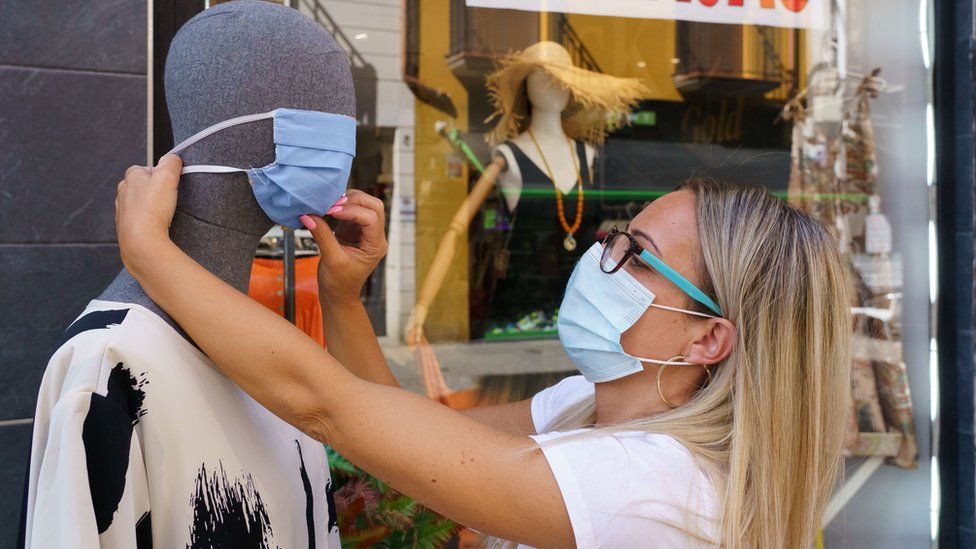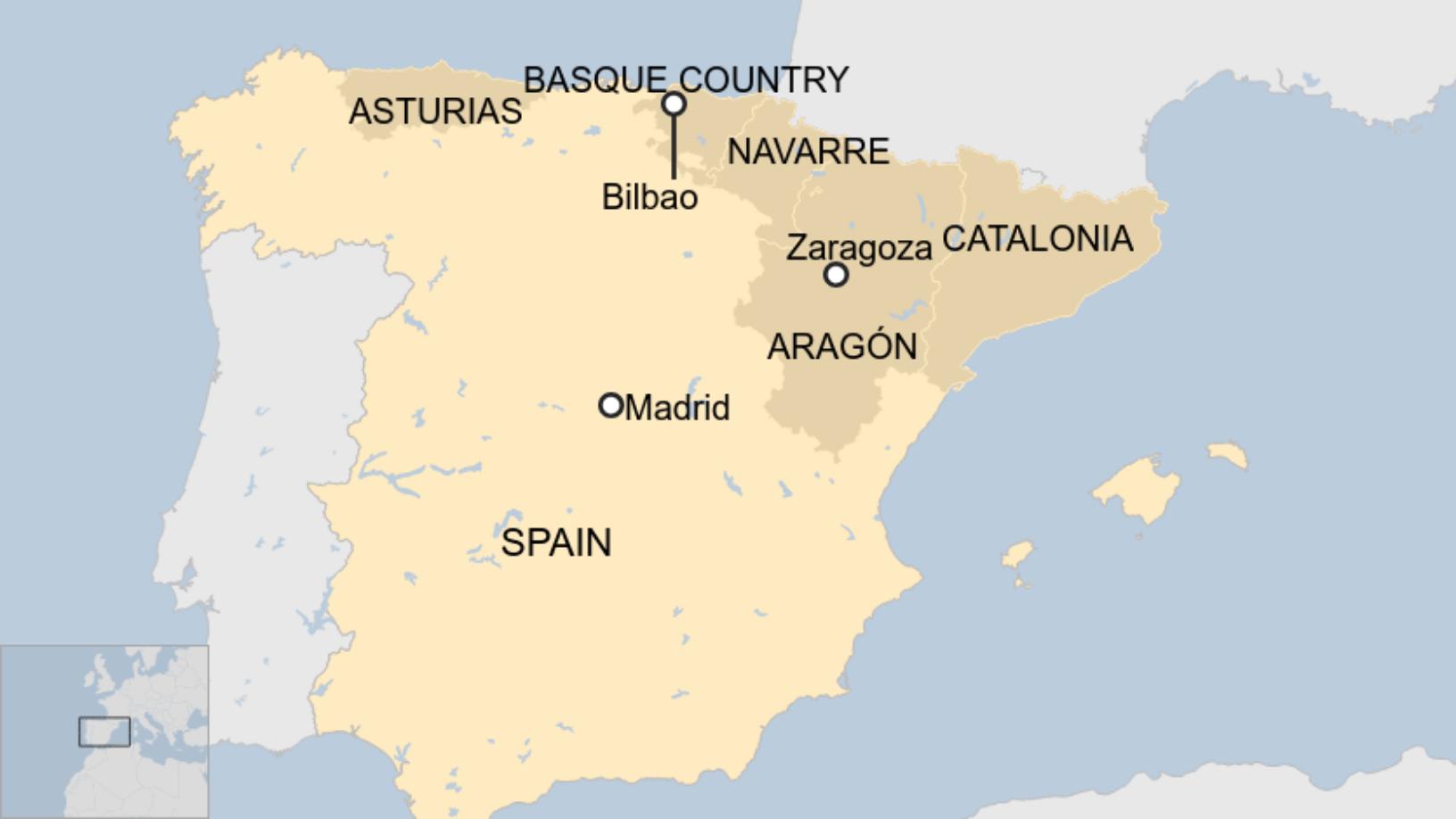Coronavirus: Why Spain is seeing second wave
- Published

Spain saw one of the most draconian Covid-19 lockdowns in Europe, but two months after it was lifted, the virus is spreading faster than in any neighbouring nation.
It now has Europe's fastest-rising caseload, with 142 positive cases per 100,000 inhabitants over the past two weeks.
By the time the state of emergency ended on 21 June, Spain was registering 100 to 150 cases per day. That number has risen to more than 3,000.
But the number of deaths over the past week stood at 122 on Thursday, a far cry from the 950 registered on 2 April alone, the blackest day in Europe's deadliest per capita coronavirus epidemic.
Is it just the young?
Most of the transmission is now between young people, and around three-quarters of positives are in patients who show no symptoms.
I work in a night bar near the beach and there are a lot of young people drinking and smoking together. The problem is young people don’t understand how this virus increases
Spain's government admits the numbers are "not what we want to see", but points to key differences compared to the spring.
Only around 3% of current cases require hospital treatment, less than 0.5% need intensive care and the current death rate is as low as 0.3%.
"Mortality is very low, as is the hospitalisation rate. Something has changed big time, although the rise is still worrying," says Ildefonso Hernández, a professor in public health from Miguel Hernández University in Alicante.
"As long as cases are rising, we have to think that a second wave is on the way. We don't have much time to react before September's return to routines."
Magaluf's famous party streets are now like a ghost town
Spain's tourism season has ended up as little more than a damp squib, as most countries moved to blacklist this key destination within weeks of the country opening up at the end of June.
That means beach areas have so far avoided the highest rates of infection, although Catalonia's infection rate is slightly above the national average on 145 cases per 100,000 inhabitants.
Why one region has been hit hard
Healthcare is a competence of Spain's 17 regions, and some are looking much better prepared than others. At the good end of the scale, the northern region of Asturias has an infection rate of 32, while Aragón in the north-east is topping 500.
Aragón's capital, Zaragoza, has become a hotspot for community transmission over recent weeks, but the problems began in the early summer when thousands of seasonal workers, many of them wandering migrants, began to travel to orchards in the region.

Growers and packing companies have been criticised for not providing accommodation for migrant workers, leading them to travel between shelters and fields or subsist in insanitary shanties.
"Everything happening in Aragón is very much connected to outbreaks among the seasonal fruit-pickers. There should have been more anticipation of the problems that could arise due to the accommodation situation of these workers," explains Juan González Armengol, president of the Spanish Society of Emergency Medicine (Semes).
Worst of all, more than 55 care homes for the elderly in Aragón have registered cases since the end of the state of emergency.
There is a risk that areas that escaped the worst ravages of the spring pandemic could be hit by a second wave as autumn nears.
In June, Aragón estimated around 760 deaths in residences, 10 times fewer than in Madrid.
To keep Covid out of care homes, PCR (antigen) tests should be done on workers and visitors each week or fortnight. That kind of thing could and should be agreed nationally
How poisonous politics is putting Madrid at risk
Spanish politics has lacked any consensus or spirit of collaboration in managing the coronavirus crisis.
While the national government of Socialist Prime Minister Pedro Sánchez has faced accusations from rivals of lying about death rates, the regional government in Madrid run by the conservative Popular Party has attracted equally fierce criticism.
Despite a shocking collapse of Madrid's public hospital system in the spring, and with 50% more deaths than the more populous region of Catalonia, the capital is now seeing cases double week after week.
Madrid had fewer than 200 contact tracers by the end of July. Double that number had been promised, and even that was half the figure recommended by the medical community.
Watch as anti-mask protesters take to the streets of Madrid
"Among the factors for the high infection numbers we are seeing, the quality of Spain's democracy is playing a part. Were accountability stricter, it would not be acceptable that some regions - and not just Madrid - are taking so long to put measures in place," says Prof Hernández.
Spain's Covid-19 pandemic
- Officially, 28,813 have died from Covid-19 - Spain's health ministry counts only those who tested positive for the virus
- According to excess death statistics, close to 44,596 are believed to have died from the illness
- The Spanish government says more than 19,000 elderly people have died in care homes, although only around half have been included in the official death toll
- As infections surged, hospitals in many areas stopped sending ambulances to care homes, so residents died undiagnosed and often with very little treatment
- "Never again can we leave our old people to die alone and afraid," said Ximena Di Lollo of Doctors Without Borders, which has criticised a lack of preparation and poor staffing levels.
- Inside story of Spain's care home tragedy
How Spain's youth accelerated northern surge
For three months, Spaniards were under lockdown. That meant many young people were stuck in their family homes.
Perhaps unsurprisingly, street parties and night life are now being signalled as the biggest catalysts of new outbreaks along with family gatherings.
Town and city festivals have all been cancelled. That did not stop crowds gathering in Navarre's capital of Pamplona for the 7 July start date of the world-famous San Fermín bull-running fiesta.
Last Friday 400 young revellers paraded the streets of nearby Tafalla, marking the town's "non-festival".
In the neighbouring Basque Country, which is just ahead of Navarre as Spain's third worst-affected region this month, youthful gatherings have also been linked to outbreaks.
Of the 350 people called to turn up for testing after a busy night at Bilbao's Back&Stage nightclub last month, at least 34 proved positive, the kind of result that has prompted an agreement between Spain's authorities to close down all nightlife after 01:00.
"It was like any other night at the club and many people were not wearing a face mask even when dancing. I was among the first to take mine off," 18-year-old Arkaitz Serrano told newspaper El País.
"Spaniards were extremely fastidious about following the rules during the lockdown, but there has been a massive relaxation now we have returned to a kind of normality," notes Prof Hernández.
Under new emergency powers, the Basque government this week banned so-called botellón parties, alcohol-fuelled outdoor gatherings of young people.
But the botellón is a national problem.
In Madrid the regional government has asked for police reinforcements to seek out and break up such parties, whose numbers are rising as restrictions on nightclubs and bars take effect.
- Published4 July 2020